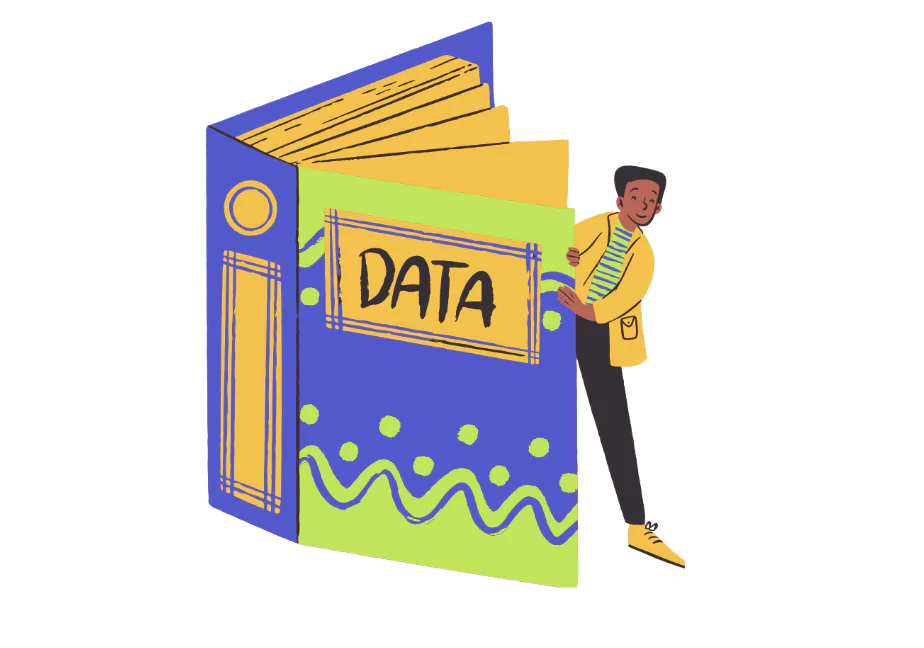Are you familiar with the data source? Each and every data available over the internet has a source that it originates from. In data analytics and business intelligence data source is important for analysis as it provides raw data for analysis purpose. Data Source is of different types and eliminates the use of manual data collection which also saves resource and time.
A data source can have different origins nowadays ranging from physical device storage to cloud based platforms for data storage in the modern business landscape. In this blog, we will learn more about data source and its significance in data science and analytics.
What is a Data Source?
The initial location from which a data originates or converted into digital form is known as a data source. A data source is generally a storage space such as a database, file or measurements recorded on a gadget.

It is important to be familiar with different data sources in order to make informative decision making based on the data available for analysis purpose.
| “Data source is a physical or digital location which stores data in different forms which can be accessed for further analysis purposes.” |
Data sources can be used when we have to extract crucial insights from data and perform data transformation. For example, let us take Google maps which uses gadgets GPS and app activities logs to collect data and use it for further recommendation on services and products.
Your device sensors collect your location, speed and other data which can be used for further analysis and personal recommendation purposes by Google services. The data in Google maps can be used for real time traffic updates, personalised suggestions, and navigating decisions.
Read More: Fundamentals of Database Systems: DBMS
Why Need Data Sources In Analytics?
Data source is the location from where raw data can be accessed and used for further analysis purposes. With a data source you can extract data for further transformation, analysis and processing. Data sources can be in the form of databases, APIs, files, digital measurements, and more.
| “Analytics is only as powerful as the data behind it. Data sources make it possible to provide powerful insights, automation and help in making data driven smart decisions.” |
We need data sources to generate insights from the raw data available from different sources which help us make data driven decisions. Data sources power up analytical tools such as Python, Tableau, Power BI, and more. Data sources can monitor revenue, collect information in the form of data such as revenue, conversion rate, and more.
Evolution of Data Sources
Data collections existed in practice for a long period of time which gradually moved from clay tablets to digital recordings. Data source evaluation started with technological advancements. With computers now we can store a large volume of data in a digital format.
Modern data sources are based on digital databases and cloud based platforms. Data analysis has advanced on a major scale with the introduction of digital advancements. This transformation leverages organisations with more informed data driven decision making and helps companies in achieving their long term goals.
With data coming from various sources this abundance and technology offers a chance for organisations to extract crucial insights and provide personalised recommendations, predict trends, useful insights, and more.
Join our Data Science Telegram channel for exclusive updates and tips!
How Does Data Source Work?
Data Sources are the origin point from where data is collected, stored and organised. They act like a bridge between tools, applications and systems. Some of the important elements of data source are data model, data source connectors, copying, protocols, APIs and sharing data resources.

The data source connectors are used to connect different applications like databases, web services and more. It enables seamless data transition. The data sources can easily be copied, shared, and reused across different systems and by multiple users. Data from different sources can be transferred using the standard network protocols and APIs.
Real World Examples of Data Sources
Google Analytics is a platform which is a powerful data source used for collecting data from websites and mobile applications. Google analytics collects data by tracking code which is added to every page of a website. The user activities on the website are tracked and monitored in real time.
Some real time tracking data are page views, clicks, bounce rate, session duration, and more. Data is sent to google analytics servers and stored in structured format. You can use this data to perform major operations and extract useful insights to help in making informed data driven decision making.
Another real world example of data sources is Salesforce CRM which is used by businesses to manage customer interactions, marketing campaigns, sales pipelines, and more. Salesforce is a master of data collection with leads, service requests, contact details, and communication history all at one place.
What is the use of Data Source?
Data Source is the starting point of overall analytics, optimisation, trends, predictive analytics, forecasting and more. Without a data source we will have nothing to start with in the first place. Data source main deliverable is to collect and provide crucial information for digital platforms to help them make transformation in this data and extract crucial insights for trend analysis, social marketing, forecasting, decision making, and more.
Data sources can include students’ names, nameplates, address, contact information, and more. With the help of a data source you can collect and process data easily without manually involving your resource and time for manual collection of data.
Types of Data Sources

The major types of data sources are listed below.
1. File Based Data Sources
This file based data source stores files or documents in CSV, XML, TXT, JSON, or Excel format. It is generally used for data entry, pre-processing, reporting, and more. They are easy to use and share but provide no real time and scalability features.
2. Database Data Sources
They exist in the form of structured data as tables within the complete Database Management System (DBMS). Some popular examples include PostgreSQL, MySQL, Oracle, MongoDB, and more. They can be used for handling customer data, transactional data, product catalog and more. Also, they are scalable and secure types of data sources.
3. Cloud Based Data Sources
One of the most popular alternative sources of data is cloud infrastructures and services. The data is hosted on cloud platforms which can be accessed using the internet. This type provides faster processing and scalable storage options for users.
You can easily access data with remote access and get real time updates easily. However, you will need to keep your internet connection strong.
4. API Based Data Source
This type of data source collects data from the web platforms and delivers it for further process using APIs. For example Openweather API, Twitter API, Google Maps APIs, and more. They provide real time data for users for further transformation and processing.
You will get third party integrations along with real time updates and automation. However, you will need to have a good technical setup along with rate limits.
5. Manual Data Entry Sources
This type of data entry sources are entered manually by human hands using forms or User interface available. It usually takes place in surveys, feedback and review collections using Google forms, Surveymonkeys, and more. However, it is prone to human errors hence needs to be handled carefully.
Difference Between Data Sources and Database
Data Sources and database are two parts of analytics required in different organisations. Let us get familiar with some of the major differences between data sources and databases.
| Data Sources | Database |
| The initial location from which a data originates or converted into digital form is known as a data source. | Database is the structured format or system used to store and manage data systematically. |
| Data sources act as a provider or originator of the data to systems. | Database stores data in an organised way for easy access, management, and retrieval. |
| Data sources consist of excel files, google sheets, IoT sensors, web pages, APIs, and more. | Databases consist of MySQL, PostgreSQL, MongoDB, and more. |
| Data sources are mostly unstructured initially. | Databases are generally present in structured or semi structured format. |
| They can be connected using APIs, Protocols, or connectors | They are generally connected using SQL queries |
| The data sources can range from small files to extremely massive streams. | Databases generally contain well defined and optimised to handle large datasets. |
Also Read:
- Data Farming Explained: 5 Modern Methods, Future Opportunities
- Data Scrubbing 101: What It Is, Why It Matters & How to Clean Data Effectively
- Data Architecture Explained: 8 Key Responsbilities for Effective Data Management
- What Is Model Evaluation in Machine Learning? 7 Powerful Methods Explained
Master Data Science with PW Skills
Become a master of extracting useful insights and handling different techniques of data science and analytics with PW Skills Data Science Course with Generative AI. Get the benefits of Generative AI and level up your skill ten times with the power of artificial intelligence in its best form.
Work on real world projects, practice exercises, module assignments, and strengthen your concepts along with the portfolio. Get yourself prepared for a job with this complete data science course. Also, get your industry ready certification with PW Skills after completing the course.
Join our Data Science Telegram channel for exclusive updates and tips!
Data Sources FAQs
Q1. What is a Data Source?
Ans: A data source is generally a storage space such as a database, file or measurements recorded on a gadget. Data source provides raw form of data from different sources.
Q2. What is the use of a data source?
Ans: Data sources can be used when we have to extract crucial insights from data and perform data transformation. For example, let us take Google maps which uses gadgets GPS and app activities logs to collect data and use it for further recommendation on services and products.
Q3. Why do we need data source?
Ans: Data sources eliminate the need for manual collection of data from different sources. With advanced technologies like google analytics, Salesforce, and more can be used to collect data which can further be used for processing, transformation and decision making.
Q4. What is a data source example?
Ans: One of the best data source examples is Google analytics which can be used to collect data, track sales leads, and monitor collection of data. This data source is further used for transformation and taking useful data driven decision making.
Q5. What are the types of data source?
Ans: The data source can be categorised into three types i,e. Primary, secondary, and tertiary data sources. Learn more about them in this article.

